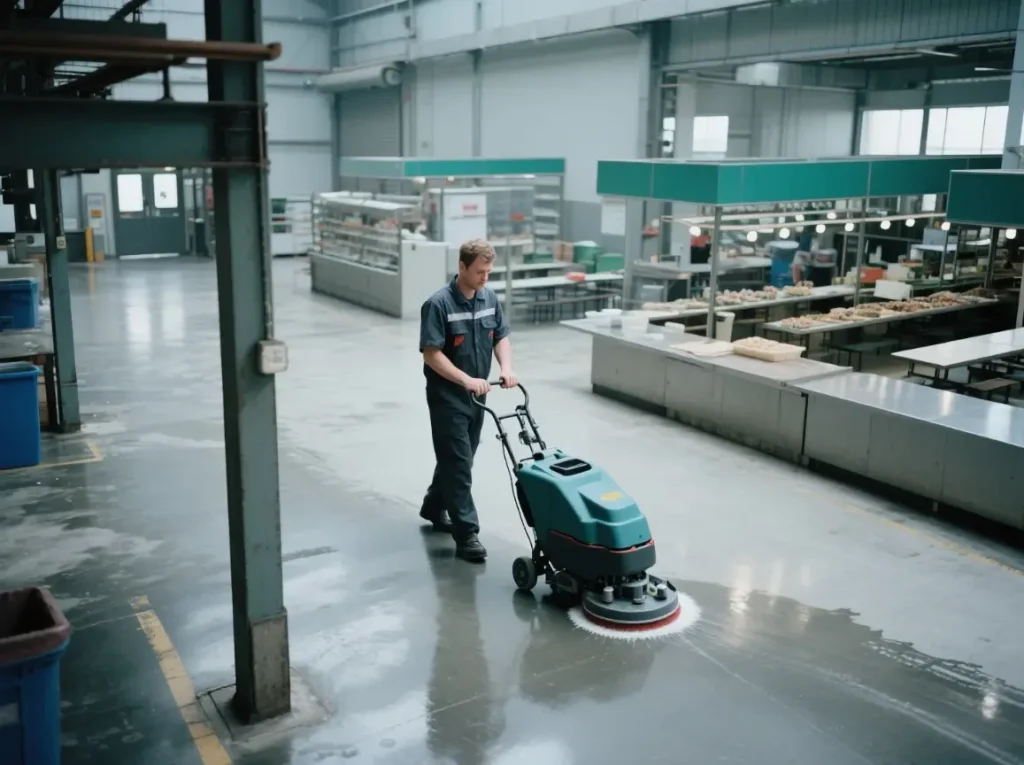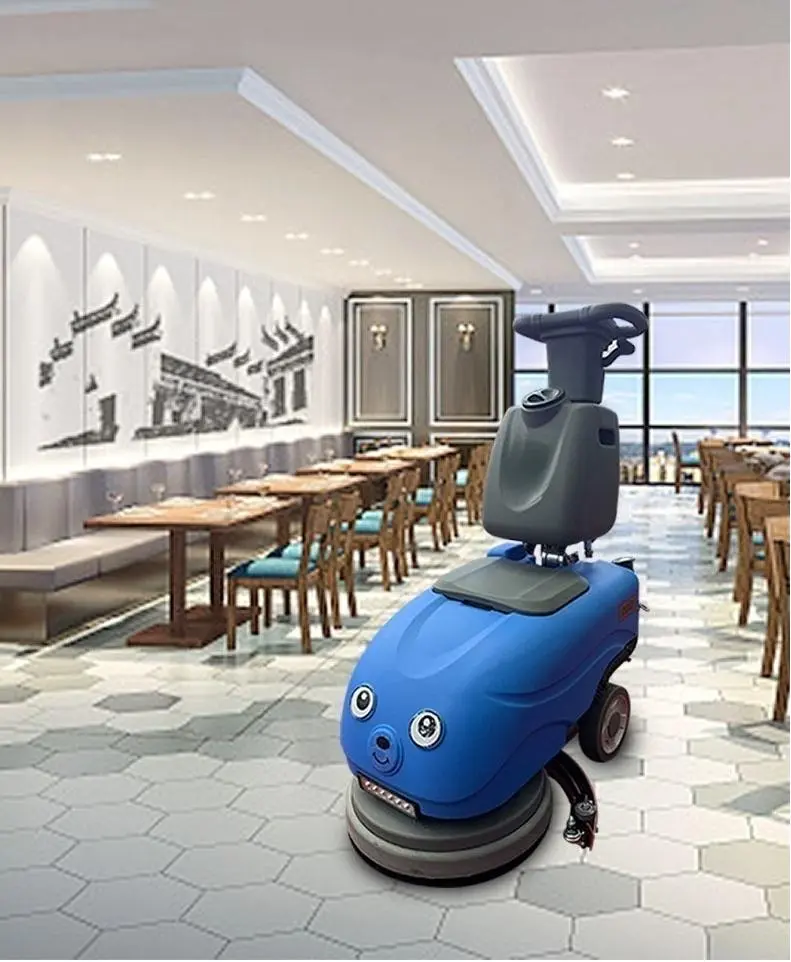산업용 바닥 청소기 사용 설명서: 효율적인 청소를 위한 완벽한 가이드
Release time: 2025-10-10
목차
Industrial floor scrubbers are essential cleaning tools for maintaining large commercial spaces, warehouses, factories, and other industrial facilities. These machines help to maintain cleanliness also ensure safety and efficiency in work environments. If you’re new to industrial floor scrubbers or looking to maximize their effectiveness, this comprehensive user manual will guide you through everything you need to know—setting up the machine, operating it, and performing regular maintenance.
What Is an Industrial Floor Scrubber?
안 industrial floor scrubber is a mechanized cleaning device designed to scrub, wash, and dry floors in large commercial or industrial environments. These machines are particularly useful in spaces like warehouses, hospitals, shopping malls, and manufacturing plants, offering an efficient solution to large-scale cleaning needs. Depending on the space and mobility requirements, you can choose from walk-behind or ride-on scrubbers.
Types of Industrial Floor Scrubbers
Understanding the different types of industrial floor scrubbers is key to choosing the right one for your space:
1. 보행형 바닥 청소기
- Ideal for smaller areas such as retail stores, office spaces, or tight aisles.
- Compact and maneuverable, allowing operators to clean in narrow spaces with ease.
- Cost-effective and perfect for environments where larger ride-on models may not fit.
2. 탑승형 바닥 청소기
- Designed for larger spaces like warehouses, factories, and distribution centers.
- These scrubbers feature a seat for the operator, which boosts comfort during long shifts and increases efficiency.
- Expensive but powerful, offering more coverage and greater cleaning power.
3. Automated Floor Scrubbers
- Robotic floor scrubbers that require minimal human intervention.
- Featuring advanced sensors, these scrubbers can navigate and clean large areas autonomously, ideal for continuous cleaning in low-traffic environments.
Setting Up Your Industrial Floor Scrubber
Proper setup is crucial for optimal performance and longevity of your industrial floor scrubber. Here’s how to get started:
1. Unbox and Inspect the Machine
- Ensure that the scrubber is intact and all components are included, such as the solution tank, scrubbing brushes, and squeegee.
- Look for any shipping damage, and notify the supplier if anything is missing or damaged.
2. Fill the Solution Tank
- Add floor cleaning detergent and water into the solution tank. Be sure to use the recommended cleaning solutions to avoid damaging the machine.
3. Install Brushes and Squeegee
- Attach the scrubbing brushes to the machine base and the squeegee to the rear for effective water recovery.
4. Charge the Battery (If Applicable)
- If your model is battery-operated, ensure it’s fully charged before starting. This ensures the machine lasts for the full duration of your cleaning task.
5. Safety Check
- Conduct a safety inspection of the machine before use, checking for any loose parts or exposed wires to prevent accidents.
How to Operate Your Industrial Floor Scrubber
Once your industrial floor scrubber is set up, here’s how to operate it effectively:
1. Adjust the Settings
- Customize settings like water flow, brush speed, and suction power depending on the type of floor and cleaning task.
2. Start Cleaning
- Begin moving the scrubber across the floor. Work in steady passes, ensuring overlapping areas to avoid missed spots or streaks.
3. Monitor the Recovery Tank
- Empty the recovery tank regularly to avoid overflows and ensure efficient suction during operation.
4. Handle Obstacles and Corners
- Use the scrubber’s edge-cleaning feature, if available, or perform spot cleaning in areas that are harder to reach, like corners or around obstacles.
5. Finish the Job
- After cleaning, turn off the machine and clean any leftover solution from the brushes and squeegee. This helps maintain performance for the next use.
Maintenance and Care of Your Floor Scrubber
Proper maintenance is key to ensuring your industrial floor scrubber continues to perform well and lasts longer. Here’s a breakdown of daily, weekly, and monthly maintenance tasks:
Daily Maintenance
- Empty the Solution and Recovery Tanks: Prevent mold or mildew buildup by emptying the tanks after every use.
- Clean Brushes and Squeegee: Wash them thoroughly to remove any dirt or cleaning residue.
- Check the Battery: If you have a battery-operated scrubber, ensure it’s charged for the next use.
Weekly Maintenance
- Inspect the Machine: Look for loose parts or signs of wear on the brushes and squeegee.
- Replace Worn Brushes: Ensure that brushes are in good condition to maintain effective cleaning.
Monthly Maintenance
- Clean Filters: If your scrubber has filters, clean them monthly to ensure good suction and water recovery.
- Check the Vacuum System: Look for clogs or damage, especially in the suction hose.
Troubleshooting Common Issues
If you encounter any problems, here are some common issues and their solutions:
1. Machine Won’t Start
- Check the power source or battery charge. If everything is connected properly and the issue persists, inspect the fuse or circuit breaker.
2. Poor Suction
- Clean the suction hose and ensure the squeegee is functioning properly.
3. Uneven Cleaning Results
- Check the brush settings and ensure they are appropriate for the floor type. Also, make sure the brushes aren’t worn out.
Maximize Efficiency with Your Industrial Floor Scrubber
By following the tips and maintenance advice outlined in this user manual, you can significantly improve the performance and lifespan of your industrial floor scrubber. Whether you’re dealing with large warehouse floors or tight retail spaces, a well-maintained floor scrubber will ensure cleanliness, safety, and operational efficiency.



